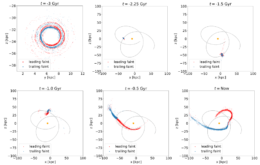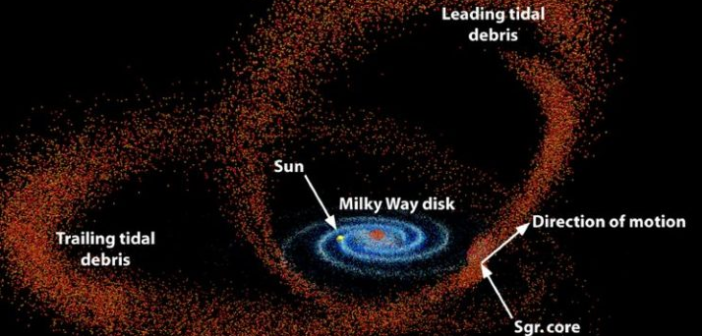Editor’s note: Ben Cassese is a second-year graduate student at Columbia University, and he was recently selected as the 2022–2023 AAS Media Fellow. We’re excited to welcome Ben to the team and look forward to featuring his writing on AAS Nova regularly!
The Sagittarius stellar stream is split into two branches: a large, bright river of stars and a smaller, fainter parallel creek. What’s the cause of this fissure, and where did the stars in this sibling stream come from?
A Stream of Stripped Stars
The Sagittarius (Sgr) dwarf galaxy has a complicated past with the Milky Way. The two galaxies have been slowly merging for several billion years, but the process has not gone smoothly for both parties. Although the Milky Way has been largely unaffected, many of Sgr’s original constituent stars have been stripped away and stretched into a long filament that wraps all the way around our sky. This is referred to as the Sagittarius stellar stream, and it was first discovered in the early 2000s.

The on-sky locations for a sample of actual stars in the Sgr stream, overplotted with the final locations of the test particles in their simulation that ended in the faint branch. Click to enlarge. [Oria et al. 2022]
Disky Beginnings
To reach their conclusion, Oria and collaborators created a suite of artificial disks, each with their own inclination, angular momentum, and collection of massless test particles meant to represent stars. They then injected these disks into a previous model of the Sgr–Milky Way merger that did not reproduce the separation into different branches. After letting the simulation run, they checked which disk configuration best recreated the faint stream. Curiously, this best disk turned out to be nearly perpendicular to both the Milky Way’s plane and Sgr’s orbital plane.

The locations of selected test particles over the course of a simulation. Note the difference in scales between the top left panel and all other panels: this initial zoom shows that all particles that ended in the faint branch began nestled in initial spirals. Click to enlarge. [Oria et al. 2022]
New Ingredients
In summary, Oria and collaborators suggest that the stars that make up the faint branch of the Sgr stellar stream likely originated in a misaligned, spiraled disk. This model successfully reproduces today’s observed faint branch structure, but it is not without flaws: it over-predicts the thickness of the main branch and opens new questions about the origins of the spiral. Excitingly, though, the authors suggest that their disk can be added to a more complete model of the Sgr merger in the future, meaning this new ingredient brings us one step closer to a full reconstruction of Sgr and its slow destruction.
Citation
“Revisiting a Disky Origin for the Faint Branch of the Sagittarius Stellar Stream,” Pierre-Antoine Oria et al 2022 ApJL 932 L14. doi:10.3847/2041-8213/ac738c

